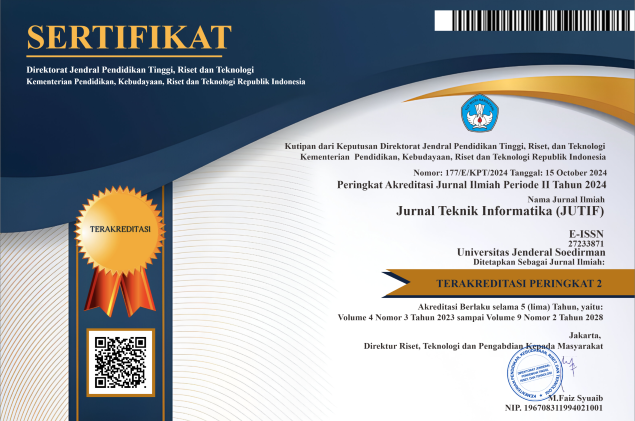Comparison of Accuracy and Computation Time for Predicting Earthquake Magnitude in Java Island
DOI:
https://doi.org/10.52436/1.jutif.2025.6.4.5044Keywords:
Earthquake, Linear Regression, Neural Network, Random Forest, Support Vector MachineAbstract
Java Island has numerous active faults, making earthquake magnitude prediction a crucial component of disaster mitigation efforts. This study conducted a rigorous comparative analysis of four machine learning algorithms—Random Forest, Neural Network, Linear Regression, and Support Vector Machine—to determine their effectiveness in this specific task. The methodology employed involved systematic hyperparameter optimization for each model to ensure a fair and robust evaluation, with performance measured by Root Mean Squared Error (RMSE), Mean Absolute Error (MAE), and training time. The results showed that all three nonlinear models significantly outperformed Linear Regression. Random Forest achieved the highest accuracy (RMSE 0.5445), but Support Vector Machine and Neural Network demonstrated very competitive and nearly equal performance. The study concluded that while Random Forest has a slight advantage, several state-of-the-art models are highly capable of addressing this problem after appropriate optimization. This underscores the critical role of methodical tuning and implies that model selection in practical applications depends on a trade-off between modest improvements in accuracy and computational efficiency.
Downloads
References
A. Soehaimi, Y. Sopyan, Ma’mur, and F. Gustin, “Peta Patahan Aktif Indonesia,” 2021.
M. R. Purwanti, Z. K. Salsabila, and F. Liantoni, “Prediksi Gempa Bumi di Yogyakarta Berdasarkan Nilai Magnitudo, Kedalaman, dan Lokasi Gempa Menggunakan Naïve Bayes,” PETIR J. Pengkaj. dan Penerapan Tek. Inform., vol. 17, no. 1, pp. 122–132, 2024.
N. Pramudito, “Mengenang Tragedi Gempa Jogja 2006 27 Mei, Diguncang Dahsyat Selama 57 Detik, Ribuan Orang Meninggal Dunia,” Radar Solo, Jawa Pos, 2025.
Y. C. A. Sanjaya and I. E. Pratiwi, “18 Tahun Silam Yogyakarta Diguncang Gempa M 5,9, Ribuan Orang Meninggal Dunia,” Kompas.com, 2024.
R. H. Permana, “Kilas Balik Duka Cianjur Diguncang Gempa Dashyat,” Detik News, 2023.
M. Rizky, “Gempa Dahsyat Cianjur, Jawa Barat Terbanyak Bencana 2022,” CNBC Indonesia, 2022.
T. Detikcom, “Gempa Hari Ini 7 Juli 2024 di Batang: Kekuatan, Jenis, dan Dampaknya,” detiknews, 2024.
D. K. Rizqi, “Penyebab Gempa M 4,6 di Batang, Ternyata Ada Aktivitas Sesar Aktif,” Radar Semarang, 2024.
I. Maulita and A. M. Wahid, “Prediksi Magnitudo Gempa Menggunakan Random Forest , Support Vector Regression , XGBoost , LightGBM , dan Multi-Layer Perceptron Berdasarkan Prediksi Magnitudo Gempa Menggunakan Random Forest , Support Vector Regression , XGBoost , LightGBM , dan Multi-La,” J. Pendidik. dan Teknol. Indones., vol. 4, no. 5, pp. 221–232, 2024.
A. Fauzan and D. Ahmad, “Analisis Hasil Prediksi Magnitudo Gempa Di Wilayah Kota Padang Menggunakan Teknik Random Forest,” J. Lebesgue J. Ilm. Pendidik. Mat. Mat. dan Stat., vol. 4, no. 3, pp. 1569–1576, 2023.
O. Somantri, “Prediksi Kekuatan Gempa Bumi Indonesia Berdasarkan Nilai Magnitudo Menggunakan Neural Network,” in Prosiding Seminar Nasional Informatika Bela Negara, 2021, vol. 2, no. November, pp. 203–207.
A. A. Nurhalizah, Y. Cahyana, and Rahmat, “Model Prediksi Kekuatan Gempa Dengan Menggunakan Algoritma Linear Regression Dan Support Vector Regression (Studi Kasus BMKG),” Sci. Student J. Information, Technol. Sci., vol. V, no. 2, p. 41, 2024.
O. Somantri, S. Purwaningrum, and Riyanto, “MODEL SUPPORT VECTOR MACHINE (SVM) BERDASARKAN PARAMETER WINDOWS UNTUK PREDIKSI KEKUATAN GEMPA BUMI,” JTT (Jurnal Teknol. Ter., vol. 8, no. 1, pp. 17–24, 2022.
H. Tantyoko, D. K. Sari, and A. R. Wijaya, “Prediksi Potensial Gempa Bumi Indonesia Menggunakan Metode Random Forest Dan Feature Selection,” IDEALIS Indones. J. Inf. Syst., vol. 6, no. 2, pp. 83–89, 2023.
F. E. Penalun, A. Hermawan, and D. Avianto, “Perbandingan Random Forest Regression dan Support Vector Regression Pada Prediksi Laju Penguapan,” J. Fasilkom, vol. 13, no. 02, pp. 104–111, 2023.
S. Chowdhury, A. K. Saha, and D. K. Das, “Hydroelectric Power Potentiality Analysis for the Future Aspect of Trends with R2 Score Estimation by XGBoost and Random Forest Regressor Time Series Models,” Procedia Comput. Sci., vol. 252, pp. 450–456, 2025.
A. Edianto, G. Trencher, N. Manych, and K. Matsubae, “Forecasting coal power plant retirement ages and lock-in with random forest regression,” Patterns, vol. 4, no. 7, 2023.
M. Pangaribuan, J. J., And Lestari, “Perbandingan Metode Moving Average (Ma) Dan Neural Network Yang Berbasis Algoritma Backpropagation Dalam Prediksi Harga Saham,” J. Inf. Syst. Dev., vol. 5, no. Vol 5, No 1 (2020): Journal Information System Development (ISD), pp. 26–34, 2020.
Y. P. Sugandhi, B. Warsito, and A. R. Hakim, “Prediksi Harga Saham Harian Menggunakan Cascade Forward Neural Network (CFNN) Dengan Particle Swarm Optimization (PSO),” Stat. J. Theor. Stat. Its Appl., vol. 19, no. 2, pp. 71–82, 2019.
D. Saputro and D. Swanjaya, “Analisa Prediksi Harga Saham Menggunakan Neural Network Dan Net Foreign Flow,” Gener. J., vol. 7, no. 2, pp. 96–104, 2023.
P. Sulardi, T. Hendro, and F. R. Umbara, “PREDIKSI KEBUTUHAN OBAT MENGGUNAKAN REGRESI LINIER,” in Prosiding SNATIF, 2017, vol. 4, pp. 57–62.
J. M. Sangeetha and K. J. Alfia, “Financial stock market forecast using evaluated linear regression based machine learning technique,” Meas. Sensors, vol. 31, no. December 2023, p. 100950, 2024.
M. R. Athallah and A. F. Rozi, “Implementasi Data Mining Untuk Prediksi Peramalan Penjualan Produk Hj Karpet Menggunakan Metode Linear Regression,” J. Sains dan Teknol., vol. 2, no. 3, pp. 180–187, 2023.
R. J. Kuo and T. H. Chiu, “Hybrid of jellyfish and particle swarm optimization algorithm-based support vector machine for stock market trend prediction,” Appl. Soft Comput., vol. 154, no. January, p. 111394, 2024.
Nurul Salsabila Syam et al., “Model Support Vector Machine untuk Prediksi pada Penggunaan Energi Listrik di Rumah Hemat Energi,” J. Inform., vol. 1, no. 2, pp. 56–59, 2022.
D. Tomar and S. Agarwal, “Twin Support Vector Machine: A review from 2007 to 2014,” Egypt. Informatics J., vol. 16, no. 1, pp. 55–69, 2015.
B. G. Marcot and A. M. Hanea, “What is an optimal value of k in k-fold cross-validation in discrete Bayesian network analysis?,” Comput. Stat., vol. 36, no. 3, pp. 2009–2031, 2021.
N. Selle, N. Yudistira, and C. Dewi, “Perbandingan Prediksi Penggunaan Listrik dengan Menggunakan Metode Long Short Term Memory (LSTM) dan Recurrent Neural Network (RNN),” J. Teknol. Inf. dan Ilmu Komput., vol. 9, no. 1, pp. 155–162, 2022.
Additional Files
Published
How to Cite
Issue
Section
License
Copyright (c) 2025 Abdul Hakim Prima Yuniarto, Taqwa Hariguna, Devi Astri Nawangnugraeni

This work is licensed under a Creative Commons Attribution 4.0 International License.



























